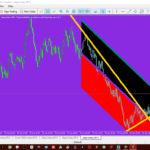Price action trading is one of the most effective and popular strategies used by traders, especially when trading Boom and Crash indices. Unlike indicators that rely on calculations and past data, price action trading focuses solely on the price movement of the market. This approach allows traders to read and interpret the market based on historical price behavior and trends, making it a powerful tool in the highly volatile markets of Boom and Crash.
In this article, we’ll explore the best price action strategies for Boom and Crash trading, and show you how to use this technique to increase your chances of success.
What Is Price Action Trading?
Price action refers to the study of past market prices to make trading decisions. It involves looking at price movements on the chart without relying on traditional technical indicators. Instead of depending on moving averages, oscillators, or other complex indicators, price action traders analyze the movement of price itself.
This strategy is particularly useful in Boom and Crash trading, as these indices often exhibit distinct price patterns, spikes, and retracements that are easy to spot once you understand the basic principles of price action.
Key Price Action Concepts for Boom and Crash
Before diving into specific strategies, let’s review some key price action concepts that are essential for Boom and Crash trading:
- Support and Resistance Levels:
- Support is a price level where the market tends to find buying interest, causing price to reverse upward.
- Resistance is a price level where selling interest tends to increase, causing price to reverse downward.
- Candlestick Patterns:
- Candlestick patterns are key to understanding market sentiment. Common patterns include Doji, Pin Bars, Engulfing Candles, and Morning/Evening Stars, which signal potential reversals or continuations in price.
- Trend Lines:
- Trend lines are drawn by connecting higher lows (in an uptrend) or lower highs (in a downtrend). These lines help identify the general direction of the market.
- Price Reversals and Continuations:
- Reversals occur when the market changes direction. Look for a reversal after a significant spike in Boom or Crash, as price often retraces after each spike.
- Continuations happen when the market maintains its direction after a brief pause or pullback.
Best Price Action Strategies for Boom and Crash
Now let’s look at some effective price action strategies you can use for Boom and Crash trading. These strategies are focused on reading the market’s price movements and making quick decisions based on those movements.
1. Support and Resistance Bounce
Support and Resistance bounce is one of the simplest yet most powerful price action strategies. The idea is to trade in the direction of the trend when price reaches significant support or resistance levels.
Strategy:
- For Boom: Look for price to approach a significant resistance level. Once price reaches resistance and shows signs of reversal (a bearish candlestick pattern like an engulfing candle or shooting star), enter a sell position.
- For Crash: Wait for price to approach support and show signs of upward reversal (a bullish candlestick pattern like a pin bar or bullish engulfing). Once a reversal is confirmed, enter a buy position.
Tip: Always use a stop-loss just beyond the support or resistance level to manage risk.
Why It Works:
Support and resistance levels often act as psychological barriers where many traders expect the price to reverse. Trading around these levels increases your chances of entering a profitable trade, as the price typically reacts at these points.
2. Pin Bar Reversal
A Pin Bar is one of the most powerful candlestick patterns used in price action trading. It’s a candlestick with a long tail (wick) and a small body, signaling rejection of a particular price level. Pin bars can indicate a reversal or continuation, depending on the direction of the price movement.
Strategy:
- For Boom: After a downward spike (a sharp drop), wait for the price to form a pin bar with the wick pointing down. This signals that the price is likely to reverse and head upwards. Enter a buy trade as the price starts moving up after the pin bar.
- For Crash: After an upward spike, wait for a pin bar with the wick pointing upward, signaling that the price may reverse and start heading down. Enter a sell trade as the price starts moving downward after the pin bar.
Tip: Pin bar formations that occur near support or resistance levels are more reliable.
Why It Works:
Pin bars are highly reliable reversal signals, especially when they form at key support or resistance levels. They indicate strong rejection of a price level, which can lead to significant market movements.
3. Breakout Trading
Breakouts occur when the price breaks through significant support or resistance levels, signaling a potential continuation of the trend. Breakouts can be explosive, making them ideal for traders who want to capitalize on fast market movements.
Strategy:
- For Boom: When price breaks through a resistance level and continues upward, look for a breakout buy entry. The breakout can be confirmed by a close above the resistance level with increased volume or a strong bullish candlestick pattern.
- For Crash: When price breaks through a support level and continues downward, look for a breakout sell entry. The breakout can be confirmed by a close below the support level with increased volume or a strong bearish candlestick pattern.
Tip: Always wait for a confirmed breakout (a close above or below the level) before entering the trade. Don’t enter prematurely, as false breakouts are common.
Why It Works:
Breakouts often lead to large, fast price movements, which are ideal for traders looking to scalp or catch significant trends. These moves are especially potent in Boom and Crash markets due to their volatility.
4. Engulfing Candlestick Pattern
The Engulfing pattern is a two-candle formation where the second candle completely engulfs the first one, signaling a strong reversal. This is a reliable pattern when combined with other price action techniques like support/resistance or trendlines.
Strategy:
- For Boom: Look for a bearish engulfing candle at a resistance level or during an uptrend. This signals that the upward movement is likely to reverse, and you should enter a sell position.
- For Crash: Look for a bullish engulfing candle at a support level or during a downtrend. This signals that the downward movement is likely to reverse, and you should enter a buy position.
Tip: Ensure that the engulfing candle forms after a strong trend or at a key support/resistance level for higher reliability.
Why It Works:
Engulfing patterns show a strong shift in market sentiment and are often seen at important price levels, such as support or resistance. The pattern signals a reversal and is a great confirmation for entering a trade.
5. Trend Continuation with Pullbacks
In trending markets, especially during Boom or Crash, the price often pulls back before continuing its movement. Pullbacks are short-term reversals in the opposite direction of the overall trend, giving traders an opportunity to enter the market in the direction of the trend.
Strategy:
- For Boom: In an uptrend, wait for a pullback (a small down move) to support. Once the price shows signs of reversal (e.g., bullish candlestick patterns), enter a buy trade as the price resumes its upward movement.
- For Crash: In a downtrend, wait for a pullback (a small up move) to resistance. Once the price shows signs of reversal (e.g., bearish candlestick patterns), enter a sell trade as the price resumes its downward movement.
Tip: Use trend indicators like moving averages to confirm the direction of the trend before trading pullbacks.
Why It Works:
Pullbacks allow traders to enter a trending market at a better price, providing a lower-risk opportunity to trade in the direction of the overall trend.
Conclusion
Price action trading is one of the most effective ways to trade Boom and Crash indices. By understanding key price action concepts such as support and resistance, candlestick patterns, and trend analysis, you can significantly improve your trading skills and increase your chances of success.
The strategies outlined in this article, such as Support and Resistance Bounces, Pin Bar Reversals, Breakouts, Engulfing Patterns, and Trend Continuation with Pullbacks, are all based on the core principles of price action trading and can be adapted to different market conditions.
Remember, practice is key to mastering price action. Start with a demo account, test different strategies, and refine your skills over time. With patience, discipline, and a solid understanding of price action, you can become a successful trader in the Boom and Crash markets.








.